What are the types of nouns in the English language? Nouns are words that refer to things, places, people, animals, quality, actions, emotions, and conditions. Nouns are also called naming words since their purpose is to ascribe specific names to people, places, emotions, etc.
We can further divide nouns into 11 categories:
- Proper noun
- Common noun
- Singular noun
- Plural noun
- Compound noun
- Countable noun
- Uncountable noun
- Concrete noun
- Abstract noun
- Possessive noun
- Collective noun
Nouns are one of the eight parts of speech. The other seven are pronouns, verbs, adjectives, adverbs, prepositions, conjunctions, and interjections.
Let’s learn more about the different types of nouns.
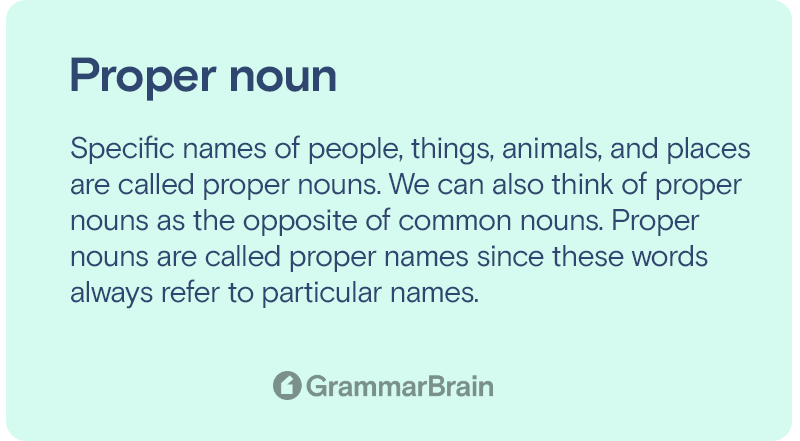
Proper noun
Specific names of people, things, animals, and places are called proper nouns. We can also think of proper nouns as the opposite of common nouns. Proper nouns are called proper names since these words always refer to particular names.
Examples of proper nouns:
People
Elon Musk, Cristiano Ronaldo
Places
London, New Delhi, Eiffel Tower, Mariana Trench
Objects
Titanic, Oreo, Coca-cola
Days and months
Tuesday, October
Companies and organizations
Twitter, McKinsey, Nokia
Proper nouns are always capitalized when we use them in a sentence. For example:
Elon Musk is now the owner of Twitter.
We visited India last year to see the Taj Mahal.
Will you be coming to class next Tuesday?
My friend is working at Microsoft, the company founded by Bill Gates.
It’s easy to identify proper nouns in a sentence. Specific names of any people, places, objects, etc. are proper nouns, and they are always capitalized.
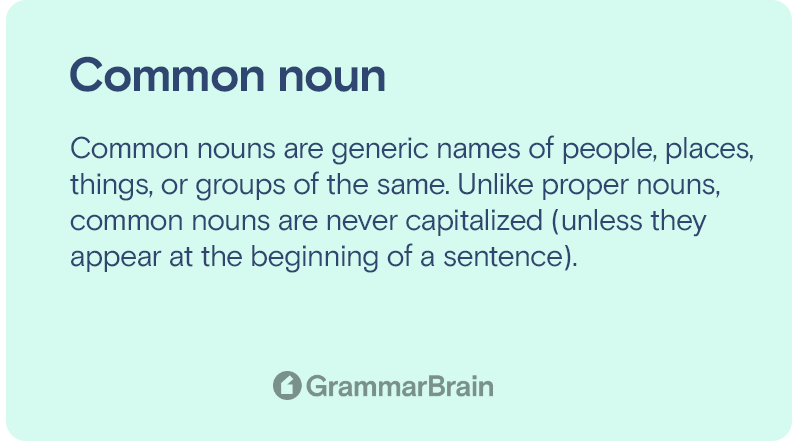
Common noun
Common nouns are generic names of people, places, things, or groups of the same. Unlike proper nouns, common nouns are never capitalized (unless they appear at the beginning of a sentence). Here are some examples of common nouns:
Places
Park, station, bus stop, airport
Food
Peanuts, mango, apple, lasagna, pizza
Feelings
Joy, sadness, sorrow, ambivalence
People
Father, mother, colleague, boss, partner
Designations
President, secretary, teacher, professor, manager
Here are some sentences with common nouns:
Are you going to the park?
I am meeting my mom after a long time.
The teacher wanted me to be silent.
Can you pass me a slice of the pizza?
It’s easy to identify common nouns in a sentence. Any noun that’s not a proper noun is a common noun. Common and proper are the two broad types of nouns, and we never capitalize common nouns.
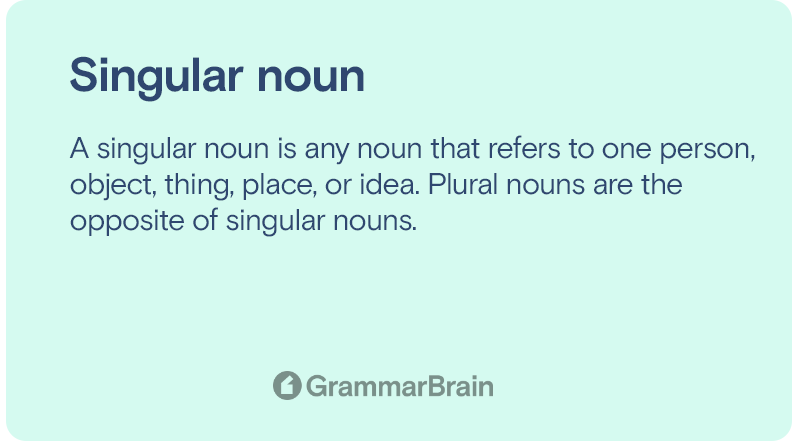
Singular noun
A singular noun is any noun that refers to one person, object, thing, place, or idea. Plural nouns are the opposite of singular nouns.
As we already mentioned, nouns refer to the names of people, places, ideas, and things. These can be both plural or singular. Names that refer to singular objects, ideas, places, and people are called singular nouns.
Here are some examples:
- Dog
- Bird
- Pasta
- London
- Microsoft
- Fear
- Hair
- Snow
- Freedom
- Fear
Singular nouns are generally easy to identify. However, it can be confusing in the context of collective nouns and abstract nouns.
For example:
- Our office has amazing people.
- There has been massive snowfall over the last 24 hours.
- The athletics team is warming up for the event.
By keeping subject verb agreement in mind while using singular nouns, grammatical mistakes can be avoided.

Plural noun
Understanding singular nouns and plural nouns go hand-in-hand. All nouns are either singular or plural. Plural nouns refer to more than one object, person, place, or idea.
Here are some examples:
- Cats
- Dogs
- Laptops
- Clouds
- Apprehensions
- Fragrances
Let’s see how plural nouns look in sentences:
The cats were playing with the dogs.
Clouds were looming over the sky.
All the CEOs gathered for a meeting.
The athletes are warming up for the race.
Barring exceptions, singular nouns become plural nouns with the suffix -s or -es. For example, cat becomes cats, cloud becomes clouds, daisy becomes daisies, bus becomes buses.
In some cases, the original word is changed to denote its plural form.
Here are some examples:
Half > Halves
Foot > Feet
Tooth > Teeth
Ox > Oxen
Phenomenon > Phenomena
As with singular nouns, be careful about subject verb agreement when using plural nouns in sentences.

Compound noun
Compound nouns are nouns made of two or more words. There are three types of compound nouns: open compound nouns, closed compound nouns, and hyphenated compound nouns.
Open compound nouns
- Tennis shoe
- Golf cart
- Full moon
- Assistant professor
Closed compound nouns
- Airport
- Keyboard
- Toothbrush
- Underworld
- Onlookers
Hyphenated compound nouns
- Bus-stop
- Mother-in-law
- Grown-ups
- Guard-of-honor
As you can see from the compound nouns above, these words act as single expressions (even when they are two separate words).
More on compound nouns.
Here are some examples of using compound nouns in sentences:
- I was at the bus-stop waiting for my friend to come
- John could see the bright full moon from his hotel window
- The martyred soldiers received a guard-of-honor
- My keyboard is malfunctioning
Put simply, compound nouns are two or more words that act together as a single noun. They can be plural or singular. We use compound nouns in speech and text when simple nouns fail to convey the desired meaning.

Countable noun
If you can count something, it’s a countable noun. Apples, oranges, cars, individuals – we can count these things. It’s fairly easy to identify countable nouns since we can’t count verbs, adjectives, adverbs, conjunctions, or interjections.
Countable nouns are contrasted with uncountable nouns.
Here are some examples of sentences with countable nouns:
She has four cats and two dogs.
There isn’t any food left.
I have some friends in my hometown.
We use the quantifiers ‘some’ and ‘any’ for both countable and uncountable nouns. However, ‘some’ is used only for plural forms of countable nouns, and ‘any’ is used in a negative sense (They don’t have any coupons remaining, I don’t have any food to give you).
Countable nouns are used in interrogative sentences as well:
Do you have a water bottle?
Can you pass me two plates of salad?
Do you have any discount coupons?
The things, objects, animals, etc. that we can count are countable nouns.
Uncountable noun
Uncountable nouns concepts, things, ideas, etc. that can’t be quantified. For example, we can’t quantify fear, love, freedom, or affection. Similarly, we can’t count water, bread, sugar, money, currency, electricity, music, sports, or information, though we can quantify them.
Unlike countable nouns, we cannot put a specific number in front of uncountable nouns. We can’t pluralize uncountable nouns – they are always singular.
Here are some examples of sentences with uncountable nouns:
Do you have some water?
Is there any milk in the fridge?
I don’t have any affection toward him.
The electricity supply was cut yesterday.
Your luggage seems heavy.
We typically don’t use a/an or numbers with uncountable nouns. Put simply, if you can’t count something, it’s an uncountable noun.
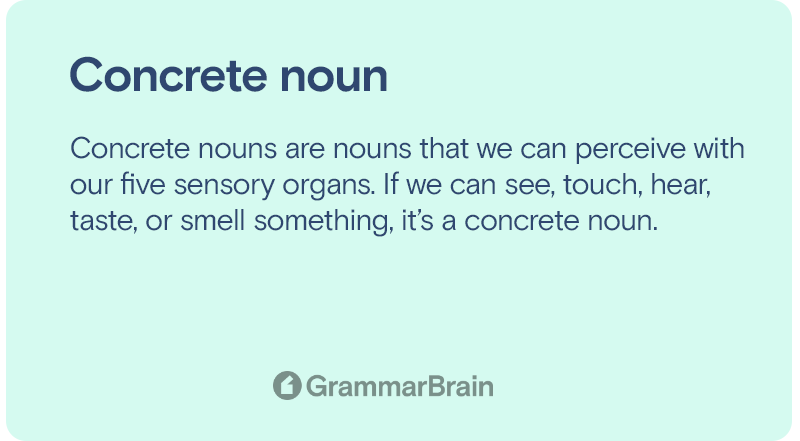
Concrete noun
Concrete nouns are nouns that we can perceive with our five sensory organs. If we can see, touch, hear, taste, or smell something, it’s a concrete noun.
Consider the following sentences:
Did you hear the doorbell? (Hear)
The waiter brought in a steaming bowl of noodles. (Taste, smell)
Your sweater is really cozy! (Touch)
The sun is shining very brightly today. (Sight)
Here’s a bouquet of flowers for you. (Smell)
The five nouns in the above sentences are concrete nouns: doorbell, noodles, sweater, sun, and flowers. We can perceive these objects with our sensory organs.
Concrete nouns are contrasted with abstract nouns. Let’s learn more about abstract nouns for a better understanding.
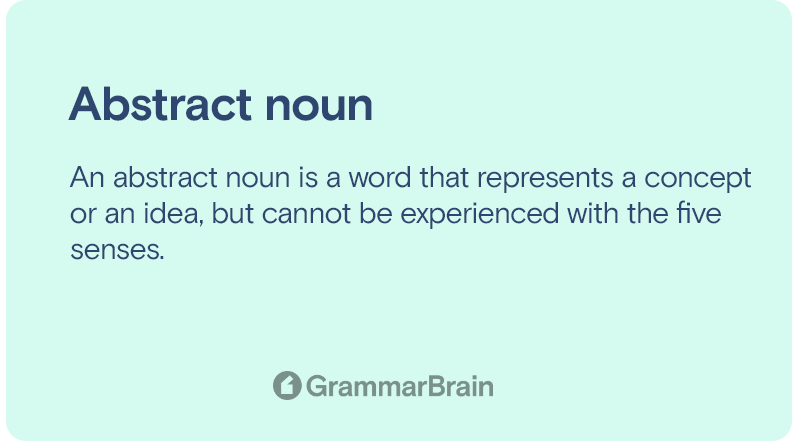
Abstract noun
An abstract noun is a word that represents a concept or an idea, but cannot be experienced with the five senses.
Abstract nouns are often created by attaching a suffix to a verb or adjective, such as:
- -tion (representing an action) – satisfaction, education, motivation, inspiration
- -ment (representing a result or condition) – contentment, achievement, acknowledgment
- -ness (representing a quality) – illness, witness, dimness, blindness, deafness
- -ity (representing a state or degree) – impossibility, heterogeneity, radioactivity, discontinuity
Abstract nouns are the opposite of concrete nouns.
Consider the following sentence:
I didn’t get any acknowledgment for my efforts.
In this sentence, we can’t touch, hear, see, taste, or smell the noun acknowledgment. The same applies to all abstract nouns.
Possessive noun
A possessive noun is a noun that shows ownership or possession. Possessive nouns are usually formed by adding an apostrophe + s (‘s) to the end of the noun.
If the noun is plural and already ends in s, add an apostrophe after the s.
Here are some examples of sentences with possessive nouns:
- This is my brother’s car.
- Do you have access to the students’ desks?
- Can you bring me my phone’s charger?
Possessive nouns are used to show ownership, not simply association. That’s why we say ‘my brother’s car’ and ‘the car of my brother’. On the other hand, we say ‘the people of the country’ to show association instead of ownership.
Collective noun
When we refer to a group of things/people/animals with a single word, it’s called a collective noun.
Consider the following examples:
- A flock of sheep was grazing in the meadow.
- The jury deliberated for hours before reaching a verdict.
- Our team played their best game of the season.
- The class was studying for their final exams.
- The family was gathered around the dinner table.
- Can you clear that heap of clothes?
In each of the above instances, a single noun represents a group of people, animals, or things. Collective nouns are common in everyday speech.
Here’s a list of common collective nouns:
- Herd
- Board
- Panel
- Bunch
- Stack
- Mob
- Gang
- Series
It’s easy to identify collective nouns once you know the meanings and functions of these words.
FAQs
1. What is a noun?
A noun is a word that refers to (or names) a person, place, thing, or idea. Names of places, people, things, feelings, ideas, etc. are called nouns.
2. What are the different types of nouns?
There are 11 types of nouns (usually describing a person, place, or thing): proper nouns, common nouns, countable nouns, uncountable nouns, abstract nouns, concrete nouns, collective nouns, possessive nouns, compound nouns, countable nouns, and uncountable nouns.
3. How are abstract nouns different from concrete nouns?
Abstract nouns are different from concrete nouns in that they refer to concepts or ideas rather than physical objects. We cannot touch, smell, hear, see, or taste abstract nouns, but we can do so for concrete nouns. For example, we can’t perceive ‘love’ or ‘freedom’ with sensory organs but we can eat ‘cake’ or watch the ‘ocean’.
4. How are proper nouns different from common nouns?
Proper nouns refer to specific people, places, or things (Taj Mahal, Australia, MacBook, Ferrari). Common nouns are generic names for things, people, places, ideas, feelings, concepts, etc. (park, swimming pool, city, computer).
5. What is the difference between countable nouns and uncountable nouns?
Countable nouns can be counted and quantified (cats, books). Uncountable nouns cannot be quantified in specific numbers (freedom, love, water).
Inside this article
Fact checked:
Content is rigorously reviewed by a team of qualified and experienced fact checkers. Fact checkers review articles for factual accuracy, relevance, and timeliness. Learn more.
Core lessons
Glossary
- Abstract Noun
- Accusative Case
- Anecdote
- Antonym
- Active Sentence
- Adverb
- Adjective
- Allegory
- Alliteration
- Adjective Clause
- Adjective Phrase
- Ampersand
- Anastrophe
- Adverbial Clause
- Appositive Phrase
- Clause
- Compound Adjective
- Complex Sentence
- Compound Words
- Compound Predicate
- Common Noun
- Comparative Adjective
- Comparative and Superlative
- Compound Noun
- Compound Subject
- Compound Sentence
- Copular Verb
- Collective Noun
- Colloquialism
- Conciseness
- Consonance
- Conditional
- Concrete Noun
- Conjunction
- Conjugation
- Conditional Sentence
- Comma Splice
- Correlative Conjunction
- Coordinating Conjunction
- Coordinate Adjective
- Cumulative Adjective
- Dative Case
- Determiner
- Declarative Sentence
- Declarative Statement
- Direct Object Pronoun
- Direct Object
- Diction
- Diphthong
- Dangling Modifier
- Demonstrative Pronoun
- Demonstrative Adjective
- Direct Characterization
- Definite Article
- Doublespeak
- False Dilemma Fallacy
- Future Perfect Progressive
- Future Simple
- Future Perfect Continuous
- Future Perfect
- First Conditional
- Irregular Adjective
- Irregular Verb
- Imperative Sentence
- Indefinite Article
- Intransitive Verb
- Introductory Phrase
- Indefinite Pronoun
- Indirect Characterization
- Interrogative Sentence
- Intensive Pronoun
- Inanimate Object
- Indefinite Tense
- Infinitive Phrase
- Interjection
- Intensifier
- Infinitive
- Indicative Mood
- Participle
- Parallelism
- Prepositional Phrase
- Past Simple Tense
- Past Continuous Tense
- Past Perfect Tense
- Past Progressive Tense
- Present Simple Tense
- Present Perfect Tense
- Personal Pronoun
- Personification
- Persuasive Writing
- Parallel Structure
- Phrasal Verb
- Predicate Adjective
- Predicate Nominative
- Phonetic Language
- Plural Noun
- Punctuation
- Punctuation Marks
- Preposition
- Preposition of Place
- Parts of Speech
- Possessive Adjective
- Possessive Determiner
- Possessive Case
- Possessive Noun
- Proper Adjective
- Proper Noun
- Present Participle
- Prefix
- Predicate



